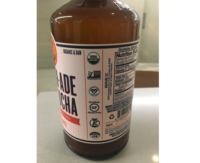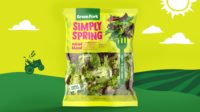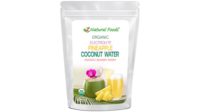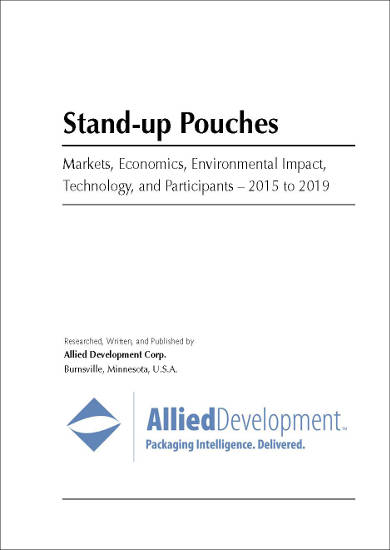Remember 2000? That’s when the AOL-Time Warner merger was announced to great fanfare. When the end began for the great technology stock boom. When mad cow disease alarmed much of Europe. And when the U.S. Supreme Court sealed a Bush victory for president.
And in packaging, a new type of flexible plastic container began its ascent.
That year there were approximately 25bn stand-up plastic pouches manufactured worldwide. Today that number has reached 165bn, according to Schönwald Consulting, used in products ranging from pet food to potatoes.
While stand-up pouches are less numerous than flat (also known as pillow) pouches which more resemble bags, they are the fastest-growing pouch type and a major growth segment in the entire packaging industry.
Worldwide, various forecasts put stand-up pouch growth at about 7% a year from 2013-2018. That far outpaces the 3% growth of the total packaging industry.
In North America, Schönwald Consulting analyst Joerg Schönwald says that stand-up pouch consumption should rise more than 5% a year through 2018, in all types of end-uses.
“The stand-up pouch is a packaging alternative for nearly all products,” he says.
The stand-up pouch of 2015 has advanced considerably from when it was introduced to the U.S. in the 1980s. New types of flexible films that extend shelf life and provide more toughness per micrometer have been developed.
Additionally value-added features such as spouts, valves, straws, handles, zippers, and tear-off tabs have been developed to provide convenience and functionality to the customer. The Freedonia Group indicated that demand for resealable pouches has risen 6.5% over the past few years, far outpacing other features such as aseptic and spouts.
For instance at Sargento Foods, more than 95% of cheese products are in flexible packaging with the majority incorporating a reclose feature. The reclosability provides convenience and portion control while adding very little cost to the package.
Companies such as Materne Industries, Campbell Soup Co., and Tree Top Inc. have turned to spouted and squeezable pouches for yogurt, baby food, and drinks—creating products that moms can toss in their bags for the playground and that toddlers can handle themselves.
“We have so many options than five years ago,” said Andy Juarez, director of engineering for Tree Top, which is now putting its fruit smoothies in a tear-top pouch. “It’s grown so fast.”
Tree Top is looking at other flexible and pouch options for its applesauce, which is traditionally sold in rigid containers. (See story on Materne’s GoGo squeeZ on p. 13)
Beverages have been slower to move to pouches, but one innovation that is garnering some notice is wine and spirits in pouches.
AstraPouch North America has created a game-changing stand-up pouch for adult beverages. A step up from the old box wine, these pouches come in various sizes from 3L wines with a built-in tap, to single-serve cocktails that can be tossed into the freezer.
AstraPouch President Dave Moynihan says while pouches aren’t the solution for every alcoholic beverage manufacturer, they are worth looking at by those making ready-to-drink beverages for the younger generation.
“They’re easy to carry, easy to chill, and there’s lot of real estate for the brand to do phenomenal printing,” he said.
While conversions from glass and plastic bottles to flexible pouches in beverages has been slower than other types of packaged goods—such as snacks and candy—Moynihan says he isn’t discouraged. He said bag-in-box applications for wine were initially scoffed at when introduced in the 1980s.
“[They thought] no reasonable people would drink wine out a plastic bag,” he said. But today bag-in-box is a $20bn business. “There’s no reason the pouch won’t be big; it may just take some time to catch on.”
Machinery
The majority of pouch manufacturing is done with form fill seal machinery, which provides simultaneous pouch production, filling, and sealing on one piece of equipment.
However, as pouches become more complex, some packaged goods companies are turning to preformed pouches that are purchased from converters. Packaging machinery makers and are adding features that can make two-part pouches, laminate multiple layers of films, and handle technologically advanced substrates.
“We’re seeing some innovation in peal and seal laminates,” says Roger Stainton, president Effytec USA, a pouch machinery company. “Where we want to apply less temperature and less pressure.” Thinner films are also becoming more prevalent, but they present a challenge as they are harder to handle and do stretch, he said.
Another innovation is in the filling. Effytec has a system that can blend various flavors of yogurt on one line, cutting down on filling steps. He added he’s continuing to see transitions of foods from paper into flexible pouches, such as flour and sugar. “Dairy in pouches is starting to take off,” as well, he said.
Sellers of nonfood goods are increasingly considering flexible pouches for items such as laundry detergents and pharmaceuticals. Along with this, suppliers are creating sophisticated barrier films, and even looking at biodegradable polymers for flexible packaging.
Consumers have come to understand, appreciate and expect the improved functionality that stand-up pouches can provide. Makers of packaged goods appreciate the lighter weight, reduced materials use and lower shipping costs of stand-up pouches.
Strong gains will continue to be made, said Schönwald. “The stand-up pouch is a success model of flexible packaging around the world.”
Editor’s note: Andy Juarez, Joerg Schönwald, and Dave Moynihan will speak at Global Pouch Forum June 11. See page 8 for agenda.
T-eeing Up Drink Pouches
T-shirts are ubiquitous so why not a T-shirt shaped pouch? Ampac first commercialized its Pull Tab-T-shirt pouch for beverages last year in Europe and North America.
The premade straw hole on the pouch body is covered by a tear-away pull-tab label that is applied by automatic label dispensers. By removing the straw the label gets preopened versus piercing through the membrane as in other beverage pouches. A stopper on the label prevents it from detaching completely, and it can be reclosed.
As the straw doesn’t puncture the laminate, it can be made with larger diameters up to 8mm and thus can be used for beverages from waters to thicker smoothies. Sizes range from 90ml to 200ml. The film is a PET/foil/PE structure and the pouch can be used for fruit juice, smoothies, stabilized milk, and other nonalcoholic and noncarbonated beverages. A version for the alcohol market is currently under development.
They are made in Europe at Ampac’s Kirchberg, Switzerland, manufacturing site. The company plans to add production in North America.
Mitsubishi Promotes Oxygen Scavenging Film in North America
Among the many active and intelligent packaging applications, oxygen scavenger packaging is attracting special attention. Mitsubishi Gas Chemical Company Inc. (MGC) is one of the enterprises that is aggressively trying to expand the global market for oxygen scavenger packaging.
In 2001, MGC developed and commercialized the oxygen-scavenger film Ageless OMAC. Instead of inserting a sachet, the package itself performs the oxygen absorption function. Ageless OMAC can be used with liquid and heat-processed foods by giving the oxygen absorption functionality to the film itself.
The Ageless OMAC film consists of three layers. The oxygen-absorbing layer is made by compounding an iron powder free-oxygen absorbing agent with polyolefin. That is sandwiched between a barrier layer and a sealant layer. Mitsubishi also developed a proprietary kneader compounding machine and a film deposition machine.
The oxygen-absorbing reaction starts in the presence of moisture and oxygen. It prevents oxidation that can deteriorate color and taste during the heating and storage of retort food by efficiently absorbing the residual oxygen in the container and dissolved oxygen in the liquid.
Triggered by the Great East Japan Earthquake of 2011, Ageless OMAC is being used more and more for the emergency provisions in addition to retorted foods such as porridges, soups, and curries and processed marine products.
One of the most widely known uses is with fruits packaged in plastic instead of cans, as it prevents discoloration. Hagoromo Foods Corp., based in Shizuoka Prefecture, has been using Ageless OMAC film for packaging fruit in flexible pouches for the last 10 years or more.
MGC plans to promote the film in the United States and is working with regulators such as the Food and Drug Administration to ensure its compliance with food standards.
Editor’s note: This story was written with the assistance of Packaging Strategies Japan.
Sonoco Bets on Flexible for Growth
With the acquisition of Brazilian supplier Graffo Paranaense de Embalagens SA, Sonoco Products Co. (NYSE: SON) is embarking on a journey to expand its flexible packaging footprint across the world.
Most U.S. based packaging companies have focused their flexible operations on North America. The Graffo deal, which just closed in May, represents Sonoco’s first investment in South America’s flexible industry and sends a message that the company intends to pursue flexible business globally.
Graffo is a small ($35mn in sales) privately held company that does rotogravure printing and foils, and paper and film lamination for confectionary, snack food, tobacco, and baking. It is not currently making pouches, but it is strategic for Sonoco, says Bob Puechl, VP and general manager of the global flexible packaging business.
“Graffo is a closely held, single-site locations with very good technologies, a very good customer base, major customers served by Sonoco here in North America and other parts of the world, and good management,” Puechl told Packaging Strategies. “Our goal is to give us acceptable business in the Brazil market and allow us to build on the business.” He said some of Sonoco’s pouch making capabilities could be transferred to Brazil to service multinational companies.
“With the equipment and space they have available, they have room for significant growth. We are willing to invest as market demand is developed and do plan on growing the business.”
Sonoco has stated that its flexibles business is a key growth area. In 2014 the business had $391mnin sales.
The other flexible presence outside the U.S. is in Malaysia where it has a composite can facility. Puechl acknowledged that Asia holds potential for Sonoco but is competitive and problematic.
“When I’m talking to customers and they say you need to be in Asia, I say define Asia,” he said. “It’s a fast-growing area but very big.” He described China as “very fragmented, very risky” for instance. “We have to be conservative as a U.S. —based company as to where we go.”
Latin America, although it has its problems with unfavorable government policies in some countries and a slowing economy in Brazil, remains fast-growing. It was a good place to serve its CPG clients globally, Puechl said.
Sonoco is already a global supplier of other types of consumer and industrial packaging and display products. In composite cans it supplies all the Pringles cans worldwide. That makes its well-placed to grow flexible, Puechl said.
“Sonoco plans to be a global player in flexible packaging. We plan to be one of the consolidators.”
Spray Paint in a Pouch
Spray paint has been around since the early 1950s—in aerosol cans. But collaboration between Printpack Inc. and Rust-Oleum Corp. has resulted in an award-winning new concept of paint in a pouch. The Flexible Packaging Assn. conveyed a gold award for packaging excellence to Printpack for the Rust-Oleum SpraySmart marking paint pouch.
Rust-Oleum turned to a flexible pouch because of problems with rigid aerosol canisters. The paint did not evacuate fully and also created a high volume of hazardous waste. In a pouch, the paint mixes and sprays more effectively, providing more coverage and the used pouches take up less space. They also do not require disposal as hazardous waste.
The 12oz pouch utilizes premium external high-barrier materials along with Printpack’s proprietary sealant film to provide a barrier to oxygen, moisture, and chemical attack. Transparent areas within the graphics allow users to easily see how much paint remains.
Beauty in a Pouch
Flexible pouch packaging has been gaining traction in the dietary supplement end-use market. Now pouch makers are seeing opportunity in the so-called “beauty-from-within” or nutricosmetics category rising in North America.
The concept is about dietary supplements delivering better skin and nail health via capsules, drinks, powders or jellies—including some that include collagen. It’s been big with female consumers in Asia since 2009 and a research report from Global Industry Analysts forecasts the world market will reach $7.4bn in 2020.
Innovative FlexPak of Springville, UT, partnered with Nippi Collagen NA Inc., Vancouver, B.C., to create a flexible pouch for Nippi’s TruMarine fish collagen Inner Beauty Jel.
The fruit-infused gel that is taken orally contains 5 grams of TruMarine collagen in a 1.2oz package. “The partnership between Nippi Collagen and Innovative FlexPak is a truly exciting opportunity that offers a breakthrough new delivery system and product to consumers,” stated Greg Nielsen, VP of Nippi, in a statement on the website.
Popular ingredients in beauty and anti-aging products include collagen, aloe vera, resveratrol, omega-3 fatty acids, vitamin E, lutein, lycopene, green tea extract, antioxidants, and peptides.
Innovative FlexPak specializes in flexible packaging and manufacturing of nutraceutical supplements, functional foods, fruit purees, energy and protein gels, juices, and syrups.
Other types of delivery systems for dietary beauty health include dissolvable powders and jellies in stick packs or sachets, and capsules in blister packs. And one report says collagen is even offered in Japan in gummies.
Putting the Squeeze on Applesauce Cups
In April 2008, Materne Industries launched a single-serve applesauce in a pouch into U.S. grocery aisles dominated by well-established foil-lidded rigid cups. By that November it had sold a million of them. Now, seven years later, the GoGo squeeZ brand is recognized as an established kids’ applesauce product and has 65% of the $350mn squeezable fruit market.
The GoGo squeeZ pouch story starts in 1998 when Materne started selling its first pouch, Pom ‘Potes, to the French market. According to Jeannette Cornell, VP of brand management and communications at Materne North America, the company saw a need for a healthy, on-the-go snack. The pouch was chosen because it’s convenient and portable and the packaging makes it easy to consume without utensils.
“Like Pom’ Potes in France, GoGo squeeZ received a warm welcome in the U.S. Parents were excited to give their children a healthy, portable, no-mess snack,” says Cornell.
The product is made from natural ingredients sourced from U.S. farms and orchards. It comes in a 3.2oz pouch with a polyethylene lining and built-in straw. In 2013, the cap was changed to the current helicopter design. The previous small, twist-off cap proved difficult for children to open on their own.
It is manufactured at a Materne facility. “We create the pouch and fill it in the same place while other companies use premade pouches from third-party vendors,” says Cornell.
GoGo squeeZ partnered with TerraCycle in 2011 to collect and repurpose the pouches by upcycling them into things like playground equipment, notebooks, and tote bags. The company hopes for a more sustainable future for the pouches. “While the cap of the product is recyclable, GoGo squeeZ has continued to place a large effort on research and development to integrate more recyclable materials into our packaging. We are working on ways to develop the first recyclable pouch product in the world,” says Cornell.
In recent years, mold has been a problem for some processed food and beverages sold in pouches, such as the Capri Sun drink. Kraft Foods, responded by introducing a clear bottom that allows consumers to see their product is safe to consume (Packaging Strategies, Aug. 15, 2014). According to Cornell, Materne is exploring the transparent packaging and has “many ideas in the research and development pipeline.” PS
Blocking Out Moisture to Keep Chips Crunchy
Toray Plastics (America) Inc. has introduced a metallized biaxially-oriented polypropylene (BOPP) film designed for use as an inner moisture- and oxygen-barrier layer in flexible packaging. One side of the PWX5 film is vacuum-deposited aluminum while the other has a low co-efficient of friction (COF) and is heat sealable.
PWX5 is laminated to a reverse-printed clear or matte OPP film and is also used as the middle ply of a three-ply lamination, for example a stand-up pouch.
There are other metalized BOPP films in the marketplace. “But none are designed with Toray’s resin formula or manufactured by means of Toray’s proprietary extrusion and metallization processes,” says Kerri Boyens, product manager for the Torayfan Division.
She said the film was developed for food customers who require moisture-, aroma- and flavor-barrier protection for an extended shelf life. It is ideally suited for salty snacks such as chips and crackers, and for cookies, biscuits, candy, and chocolates.
However, it can also be used for health and beauty products that require aroma and oxygen protection.
Boyens declined to name the customer, but it is being used by a major snack food packaging converter for a branded food line.
The PWX5 film is manufactured at Toray’s 70-acre campus in Rhode Island.
BEMIS HELPS MCCORMICK ENTER SAUCE MARKET
A new pouch produced by Bemis Co. for McCormick & Co. has the look and functionality of a bottle, with the efficiency and sustainability of a pouch. The stand-up pouch for McCormick’s Skillet Sauce brand that incorporates a die-cut spout that looks like a cap won an award for packaging excellence from the Flexible Packaging Assn.
The 9oz laminated polyester and polyethylene pouch was customized by Bemis for McCormick. Its opening “cap” designed to tear easily without scissors for a clean, controlled pour was designed by McCormick and executed by Bemis.
“McCormick saw an emerging market for sauces, dressings, and condiments,” said Jon Pietsch, marketing manager for liquid flexibles at Bemis. It wanted to differentiate and expand its offerings, and compete in the skillet sauce category against players such as Campbell Soup Co.
The company has described the sauces—which come in flavors such as fire roasted garlic chili—as liquid versions of its dried seasoning mixes. The single-use pouches were introduced in 2014.
The shape helps sets it apart from bottled sauces and attract those customers to the so-called “center aisle” of supermarkets where processed food manufacturers are “being challenged to innovate and differentiate,” Pietsch said.












